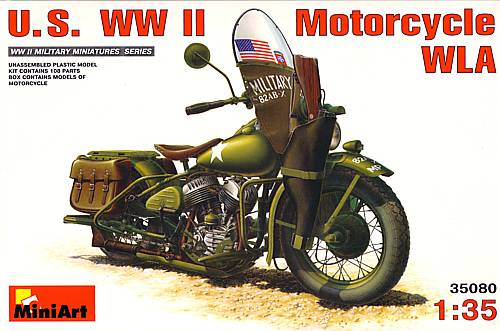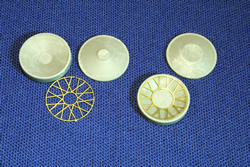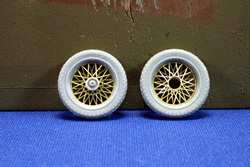|

MiniArt
35080 This
kit was a bit intimidating given the multitude of small parts and the thin photoetch
that requires some precise bending. Consequently, I built one of the Italeri bikes
I’d had on the shelf for many years just to get some practice and get familiar
with the parts. The Italeri kit is still a decent option, but MiniArt has put
a lot of effort sharpening the details and the inclusion of the p/e adds to both
the experience and the overall results. But this is not a kit for beginners—or
even intermediates that have not had a lot of acquaintance with small parts. A
magnifying lamp was definitely helpful with this kit. Here’s
another tip: cut the parts with a nipper close to the counter or table and use
the bottom of the kit box to capture the parts as they fall. Staying low to your
building surface helps minimize the “bounce” factor and the sides of
the box may keep things from jaws of the carpet monster. MiniArt
provides jigs for forming the p/e spokes and bending the parts for the front fender
supports. Overall, this works pretty well, though it’s easy to push the parts
out of shape because they are so thin. The spokes in particular need careful attention
when placing them inside the tire rims. I used a good dose of thin superglue to
keep them in place. Also,
care must be taken when attaching these wheels to their frames. I didn’t
pay attention to the different sizes in the inner rim of the photoetch that fits
to the plastic hubs, and had to remove the wheel from the rear when I discovered
it was supposed to be the front wheel. Subsequently, I never got the correct rear
wheel to sit on the plastic hub as it should have, and it is slightly off kilter
in relation to the fender above it. Fortunately, this problem is covered by the
placement of the saddle bags, but take this as a word of warning. Double check
the instructions and dry fit parts often. The
instructions are a tight series of exploded drawings. There are a few quirks,
such as not identifying part A21 which is connected to A72 in step 4. The attachment
of the left foot rest is not specified in the instructions. The drive chain in
part A26 should go over, not under, part A74. There is also a “mystery part”
A16 in Step 30 whose purpose and exact positioning I couldn’t figure out.
Later in Step 35 I saw that it is the support for the blackout lamp. I was able
to glue it to the bottom of the lamp and then insert it through the lower windscreen
section. I also
had a problem keeping the gravel pan in place, as it is anchored to the frame
only by a pair of small photoetch tabs. After having it pop off a couple times,
I put a shim below the bike that I could glue the pan to directly for a stronger
bond than the p/e and superglue provided. Another
tip regarding the two small p/e parts (PE18 and PE19) that represent the brackets
that hold the windscreen to the handlebar. Cut only one end from the fret and
form the part over a straight pin to match the curve over the handlebar. Then
cut the other end of the brass part. This should give you the approximate shape
for positioning on the bar. I may have mixed the two p/e parts inadvertantly,
but I found that what was supposed to be PE18 worked better on the opposite side
of the bar, and vice versa for the other part. If you have some nubs from the
attachment points to the photoetch fret, you can carefully sand those down with
a sanding stick after the parts have been glued to the bar.  |  |
This
kit took me a couple weeks to build, mainly because it is so fragile and the parts
are so small, and I wanted to make sure glue dried securely before moving on to
the next step. In some respects it’s a bit over-engineered in favor of detail
and accuracy. Only the scabbard for the Thompson submachine gun was a bit of a
letdown, as the gun is molded into one side of the scabbard, rather than resting
free in the sleeve. So that one side looks a bit off. MiniArt should have made
the gun stock as a separate part to glue into the scabbard. The only missing item
is thin wire, which I used to create the brake and gas lines. The
vehicle will get the standard OD finish, with a variety of blacks, silvers, and
metallic grays for the engine parts and leather color for the seat and saddle
bags. The decals are nicely printed and appear quite complete for representing
an 82nd Airborne military police motorcycle. Subsequent
to this kit, MiniArt released #35085 U.S.
Military Police with Motorcycles, with a pair of GI MPs sold separately
and with the Bantam jeep; and #35101 U.S. Motorcycle Repair Crew, with
a pair of bikes and three maintenance figures. I’m tempted to pick that one
up just for the fine looking figures. But I’d be up for building the bikes
again, too. Review
sample provided by MiniArt. -tss-
| 











